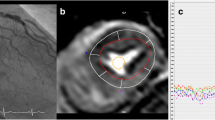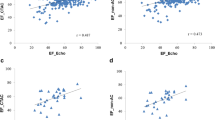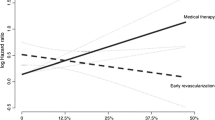Abstract
Delayed contrast-enhanced cardiovascular magnetic resonance (DE-CMR) allows assessment of reversibility of myocardial dysfunction. Comparative data to other modalities is scarce. Purpose of this study was to compare DE-CMR and 201Thallium single photon emission computed tomography (SPECT) for prediction of reversible left ventricular (LV) dysfunction in patients with chronic ischaemic heart disease. Fifty-four patients with LV dysfunction (mean ejection fraction (EF) 35 ± 8%) scheduled to undergo myocardial revascularization underwent DE-CMR and SPECT. Cine CMR was performed at baseline and at 8 months follow-up for assessment of regional and global myocardial function. Myocardial viability was determined by the segmental extent of delayed enhancement for DE-CMR, and by quantitative analysis of tracer uptake for SPECT, and was correlated to functional recovery after revascularization. After revascularization, 172 (49%) of 350 dysfunctional segments improved at follow-up cine CMR. Sensitivity and specificity for the prediction of functional recovery was 92 and 88%, respectively, for DE-CMR as compared to 86% (P = 0.4) and 56% (P = 0.001) for SPECT. Global LV function showed an increase of EF > 5% in 22 (41%) patients. The DE-CMR derived viability ratio (dysfunctional but viable myocardium) of 0.46 (sensitivity 91%, specificity 91%) was identified as predictor of increase in EF > 5% (P = 0.02), whereas the corresponding SPECT parameters were not predictive. DE-CMR compares favorably to SPECT for the prediction of regional and global improvement in LV function in the setting of chronic myocardial ischemia.



Similar content being viewed by others
References
Bax JJ, Poldermans D, Elhendy A et al (2001) Sensitivity, specificity and predictive accuracies of various noninvasive techniques for detecting hibernating myocardium. Curr Probl Cardiol 26:141–188
Di Carli MF, Maddahi J, Rokhsar S et al (1998) Long-term survival of patients with coronary artery disease and left ventricular dysfunction: implications for the role of myocardial viability assessment in management decisions. J Thorac Cardiovasc Surg 116:997–1004
Bonow RO, Maurer G, Lee KL et al (2011) Myocardial viability and survival in ischemic left ventricular dysfunction. N Engl J Med 364:1617–1625
Kim RJ, Wu E, Raffael A et al (2000) The use of contrast-enhanced magnetic resonance imaging to identify reversible myocardial dysfunction. N Engl J Med 343:1445–1453
Schvartzman PR, Srichai MB, Grimm RA et al (2003) Nonstress delayed-enhancement magnetic resonance imaging of the myocardium predicts improvement of function after revascularization for chronic ischemic heart disease with left ventricular dysfunction. Am Heart J 146:535–541
Kim RJ, Manning WJ (2004) Viability assessment by delayed enhancement cardiovascular magnetic resonance. Will low-dose dobutamine dull the shine? Circulation 109:2476–2479
Carr JCC, Simonetti O, Bundy J et al (2001) Cine MR angiography of the heart with segmented true fast imaging with steady-state precession. Radiology 219:828–834
Simonetti OP, Kim RJ, Fieno DS et al (2001) An improved MR imaging technique for the visualization of myocardial infarction. Radiology 218:215–223
Sciagra R, Santoto GM, Bisi G et al (1998) Rest-redistribution thallium-201 SPECT to detect myocardial viability. J Nucl Med 39:384–390
Cerqueira MD, Weissman NJ, Dilsizian V et al (2002) Standardized myocardial segmentation and nomenclature for tomographic imaging of the heart. A statement for healthcare professionals from the Cardiac Imaging Committee of the Council on Clinical Cardiology of the American Heart Association. Circulation 105:539–542
Bax JJ, Visser FC, Poldermans D et al (2001) Relationship between preoperative viability and postoperative improvement in LVEF and heart failure symptoms. J Nucl Med 42:79–86
Wellnhofer E, Olariu A, Klein C et al (2004) Magnetic resonance low-dose dobutamine test is superior to scar quantification for the prediction of functional recovery. Circulation 109:2172–2174
Kitagawa K, Sakuma H, Hirano T et al (2003) Acute myocardial infarction: myocardial viability assessment in patients early thereafter–comparison of contrast-enhanced MR imaging with resting 201TI SPECT. Radiology 226:138–144
Kühl HP, Lipke CSA, Krombach G et al (2006) Assessment of reversible myocardial dysfunction in chronic ischaemic heart disease: comparison of contrast-enhanced cardiovascular magnetic resonance and a combined positron emission tomography–single photon emission computed tomography imaging protocol. Eur Heart J 27:846–853
Knuesel PR, Nanz D, Wyss C et al (2003) Characterization of dysfunctional myocardium by positron emission tomography and magnetic resonance. Relation to functional outcome after revascularization. Circulation 108:1095–1100
Oudiz RJ, Smith DE, Pollak AJ et al (1999) Nitrate-enhanced thallium 201 single-photon emission computed tomography imaging in hibernating myocardium. Am Heart J 138:369–375
Bax JJ, Cornel JH, Visser FC et al (1996) Prediction of recovery of myocardial dysfunction after revascularization. Comparison of fluorine-18 fluorodeoxyglucose/thallium-201 SPECT, thallium-201 stress-reinjection SPECT and dobutamine echocardiography. J Am Coll Cardiol 28:558–564
Pagano D, Bonser RS, Townend JN et al (1998) Predictive value of dobutamine echocardiography and positron emission tomography in identifying hibernating myocardium in patients with postischaemic heart failure. Heart 79:281–288
Acknowledgment
This study was supported by the “ELAN-Programm der Friedrich-Alexander-Universität Erlangen-Nürnberg, Erlangen, Germany” (M. R. and J. v. E.).
Conflict of interest
None.
Author information
Authors and Affiliations
Corresponding author
Electronic supplementary material
Below is the link to the electronic supplementary material.
10554_2011_9941_MOESM1_ESM.avi
Video 1 Short axis cine CMR view of the patient from figure 1 (before coronary artery bypass grafting) showing akinesis in the inferior wall. CMR = cardiovascular magnetic resonance. Supplementary material 1 (AVI 837 kb)
10554_2011_9941_MOESM2_ESM.avi
Video 2 Short axis cine CMR view (corresponding slice position to video 1) of the patient from figure 1 (after coronary artery bypass grafting) showing improved wall thickening in the inferior and septal wall. CMR = cardiovascular magnetic resonance. Supplementary material 2 (AVI 1347 kb)
10554_2011_9941_MOESM3_ESM.avi
Video 3 Short axis cine CMR view of the patient from figure 2 (before coronary artery bypass grafting) showing akinesis in the inferior wall. CMR = cardiovascular magnetic resonance. Supplementary material 3 (AVI 654 kb)
10554_2011_9941_MOESM4_ESM.avi
Video 4 Short axis cine CMR view (corresponding slice position to video 3) of the patient from figure 2 (after coronary artery bypass grafting) showing no improvement of wall thickening in the inferior wall. CMR = cardiovascular magnetic resonance. Supplementary material 4 (AVI 692 kb)
Rights and permissions
About this article
Cite this article
Regenfus, M., Schlundt, C., von Erffa, J. et al. Head-to-head comparison of contrast-enhanced cardiovascular magnetic resonance and 201Thallium single photon emission computed tomography for prediction of reversible left ventricular dysfunction in chronic ischaemic heart disease. Int J Cardiovasc Imaging 28, 1427–1434 (2012). https://doi.org/10.1007/s10554-011-9941-z
Received:
Accepted:
Published:
Issue Date:
DOI: https://doi.org/10.1007/s10554-011-9941-z




